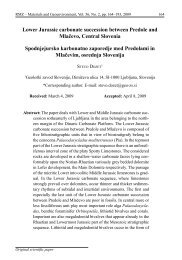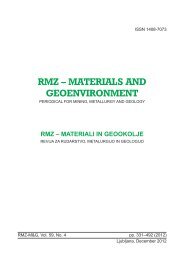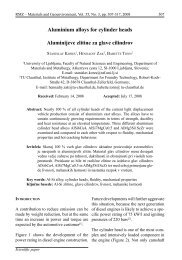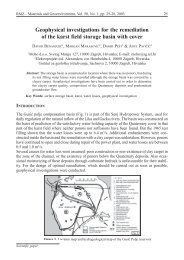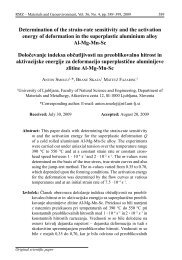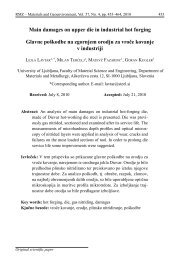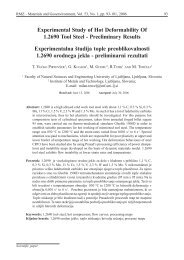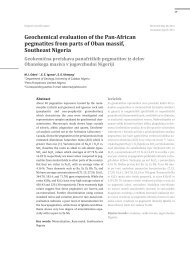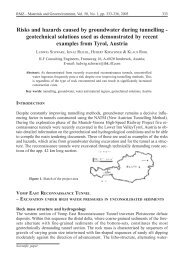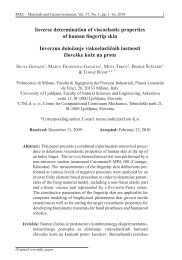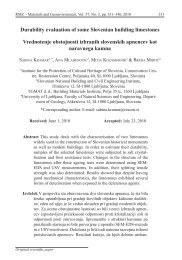Estimation of Groundwater Recharge under various land ... - RMZ
Estimation of Groundwater Recharge under various land ... - RMZ
Estimation of Groundwater Recharge under various land ... - RMZ
You also want an ePaper? Increase the reach of your titles
YUMPU automatically turns print PDFs into web optimized ePapers that Google loves.
<strong>Estimation</strong> <strong>of</strong> <strong>Groundwater</strong> <strong>Recharge</strong> <strong>under</strong> <strong>various</strong> <strong>land</strong> covers in parts <strong>of</strong> ...183ward is that, what happens to wateryield when the headwater catchmentsare planted with monoculture species.There are only limited studies carriedout to evaluate the hydrological impacts<strong>of</strong> plantation. In India, during thelast few years, considerable effort hasbeen made to <strong>under</strong>stand the impact <strong>of</strong>forest degradation on the soil hydrologicalregime. However, studies arequite limited as far as the impact <strong>of</strong> forestdegradation on groundwater regimein western ghat region.The Western Ghat region is the originand primary catchment <strong>of</strong> many rivers(west and east flowing) in peninsularIndia. The lives <strong>of</strong> the majority <strong>of</strong> therural population in the four southernstates (Kerala, Tamil Nadu, AndhraPradesh and Karnataka) plus parts <strong>of</strong>Maharashtra are thus critically dependentupon the watershed services providedby the Western Ghats forests.The portion <strong>of</strong> the Western Ghats thatlies in Karnataka state, contains themajor portion <strong>of</strong> the forests. It is reportedthat, there has been an increasedanthropogenic activities in the westernghat mountain region, a rapid change invariety <strong>of</strong> <strong>land</strong>-use and <strong>land</strong> cover aretaking place, which could have verysignificant impact on the water regime<strong>of</strong> the region, which includes the baseflowand groundwater recharge.In the present study is an attempt to<strong>under</strong>stand the impact <strong>of</strong> the <strong>land</strong>-us-es on the groundwater recharge <strong>under</strong>different rainfall regimes with changein <strong>land</strong>-use conditions. In order to facilitatethe analysis, SWIM (Soil Waterand Infiltration Movement) model ischosen. It is selected in view <strong>of</strong> its simplicityand use <strong>of</strong> input parameters (soilmoisture characteristics) that can be directlymeasured in the field/laboratory.Materials and methdsStudy AreaUttara Kannada is a district with an area<strong>of</strong> 10,291 km 2 , with its administrativeheadquarters at Karwar (Figure 1). Themain geographic feature <strong>of</strong> the districtis the Western Ghats (WG), which runsfrom north to south through the district.Between the WG and the sea is narrowcoastal strip, which varies from 8 kmto 24 km in width. Behind the coastalplain are flat topped hills from 60 m to100 m in height, and behind these hillsare the ridges and peaks <strong>of</strong> the WG.East <strong>of</strong> the WG is the up<strong>land</strong>, part <strong>of</strong>the vast Deccan plateau.In the WG region, majority <strong>of</strong> the rainfalls during June- September., i.e.,south-west monsoon. More than 90 %<strong>of</strong> the annual rainfall occurs during thefour monsoon months, with an averagenumber 120–140 rainy days per year.During the monsoon, a major portion<strong>of</strong> the rainfall is contributed by fourto five spells each lasting 8–10 days.<strong>RMZ</strong>-M&G 2010, 57



